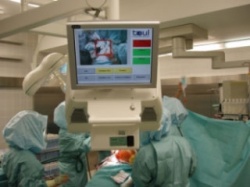Airflows fight hospital infections
Hospital infections are immensely dangerous. Toul Meditech has therefore developed a new mobile laminar airflow system which can be used in every operating room in addition to the existing ventilation system.

Hospital infections are immensely dangerous as the pathogenes causing them are increasingly resistant to most of the commonly used antibiotics. In 1974, only 2 % of Staphylococcus aureus infections in the USA were MRSA (methicillin-resistant). By 2003, that figure had soared to 57 %, and now is over 60 %. Nosocomial infections are the fourth largest killer in the United States: there, every year two million patients contract infections in hospitals, and an estimated 103,000 die as a result, that means as many deaths as from AIDS, breast cancer and traffic accidents combined.
The use of ultraclean airflow may help to transmit airborne particles from the surgical team onto the operating field and thereby increase direct airborne contamination of the wound. Every minute, an individual emits thousands of airborne particles carrying bacteria that may contaminate an open surgical wound.
Toul Meditech has therefore developed a new mobile laminar airflow system which can be used in every operating room in addition to the existing ventilation system without installation costs. Conventional airflow systems frequently do not reach the operating field as they are obstructed by the surgical light and the heads of the operating team. Toul is positioned very close to the operating field and can reduce the contamination level of the operating field and the Toul instrument table by up to 90 %.
This technology has been successfully used for more than six years in various hospitals in Sweden. It pushed the surgical infection rate below 1 % which translates into substantial cost-savings for the hospital as the need for additional treatment and longer hospital stays is reduced significantly. Toul is also an excellent solution for field hospitals as it creates immediately sterile conditions wherever you need it.
14.08.2008
More on the subject:











